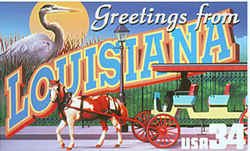
Louisiana Symbols
Louisiana State Freshwater Fish
White Perch, aka Sac-au-lait and White Crappie

(Pomoxis annularis)
Adopted on June 15, 1993.
The White Perch aka Sac-au-lait and White Crappie, (poxomis annularis, sac-au-lait,) was designated the official state freshwater fish of Louisiana on June 15, 1993 by Acts 1993, No. 460, §1.
White crappies are more common in large reservoirs and tend to be more tolerant of turbid conditions.
The name "white perch" is sometimes erroneously applied to the white crappie.
Louisiana State Fish: White Perch

The white crappie (Pomoxis annularis), is a freshwater fish found in North America, one of the two crappies.
There are two species of crappies, the Black Crappie, (Pomoxis nigromaculatus,) and the White Crappie, (Pomoxis annularis.) They are found in almost all waters with the exception of mountain streams. They are more abundant in large impoundment's, natural lakes and backwaters. White crappies are more tolerant of turbid conditions with the black crappie preferring clearer lakes.
Common Name
White Crappie, sac-a-lait, papermouth, goggleeye, white perch, speck, speckles, slab (large fish), google eye.
Characteristic of the White Perch, aka Sac-au-lait and White Crappie
Pomoxis is Greek for "opercle sharp" and refers to the fact that the fish's gill covers have spines. The word annularis is Latin for "having rings" and refers to the dark bands (vertical bars) around the body. The white crappie is deep-bodied and silvery in color, ranging from silvery-white on the belly to a silvery-green or even dark green on the back. There are several vertical bars on the sides. The dorsal fin has a maximum of six spines. Males may develop dark coloration in the throat region during the spring spawning season.
Biology
Like other members of the sunfish family, white crappie are nest builders. They are similar to bluegills in that they tend to nest in relatively large "beds," and they have very high reproductive potential which often leads to overpopulation and stunting in small lakes and impoundments. White crappie nest in the spring, generally when water temperatures reach 65 °F to 70 °F. However, spawning activity has been observed at temperatures as low as 56 °F. Fry hatch in three to five days, but remain attached to nest substrate by an adhesive substance from the egg for a few more days. Just before leaving the nest, fry free themselves by vigorous swimming actions. Once free, they begin feeding on microscopic animals. Although fry do not appear to school, fingerlings do. Schools with large numbers of individuals are often found in the middle of lakes. Typically, white crappie grow three to five inches in length the first year, and reach seven to eight inches during the second year. Maturity is usually reached in two to three years. Adults feed on small fish and insects.
Diet
They have diverse diets, however, including zooplankton, insects, and crustaceans. By day, crappie tend to be less active and to concentrate around weed beds or submerged objects, such as logs and boulders; they feed especially at dawn and dusk, moving then into open water or approaching the shore.
Reproduction
Like other members of the sunfish family, White Crappie are nest builders. They are similar to bluegills in that they tend to nest in relatively large "beds," and they have very high reproductive potential which often leads to overpopulation and stunting in small lakes and impoundments. White Crappie nest in the spring, generally when water temperatures reach 65 °F to 70 °F. However, spawning activity has been observed at temperatures as low as 56°F. Fry hatch in three to five days, but remain attached to nest substrate by an adhesive substance from the egg for a few more days.
Louisiana Law
The law designating the white perch as the official Louisiana state freshwater fish is Section §170.4 (State freshwater fish) of Louisiana Statutes, Title 49 (State administration), Section RS 49:170.4.
Title 49 - State administration
SECTION RS 49:170.4.
§170.4. State freshwater fish
There shall be an official state freshwater fish. The official state freshwater fish shall be the white perch (poxomis annularis, sac-au-lait).
Its use on the official documents of the state and with the insignia of the state is hereby authorized.
Acts 1993, No. 460, §1.
Taxonomic Hierarchy: White Perch
Kingdom: Animalia - animals
Phylum: Chordata - chordates
Subphylum: Vertebrata - vertebrates
Class: Actinopterygii
Order: Perciformes
Family: Centrarchidae (Sunfishes)
Genus: Pomoxis
Species: Pomoxis annularis







